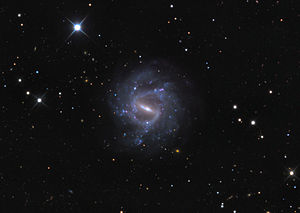NGC 1073
| Galaxy NGC 1073 |
|
|---|---|

|
|
| Image taken with a 24-inch telescope | |
| AladinLite | |
| Constellation | whale |
|
Position equinox : J2000.0 , epoch : J2000.0 |
|
| Right ascension | 02 h 43 m 40.5 s |
| declination | + 01 ° 22 ′ 34 ″ |
| Appearance | |
| Morphological type | SB (rs) c |
| Brightness (visual) | 10.8 mag |
| Brightness (B-band) | 11.5 likes |
| Angular expansion | 4.9 ′ × 4.3 ′ |
| Position angle | 15 ° |
| Surface brightness | 14.0 mag / arcmin² |
| Physical data | |
| Affiliation | NGC 1068 group LGG 73 |
| Redshift | 0.004030 ± 0.000017 |
| Radial velocity | 1208 ± 5 km / s |
|
Stroke distance v rad / H 0 |
(54 ± 4) · 10 6 ly (16.7 ± 1.2) Mpc |
| history | |
| discovery | William Herschel |
| Discovery date | October 9, 1785 |
| Catalog names | |
| NGC 1073 • UGC 2210 • PGC 10329 • CGCG 389-002 • MCG + 00-08-001 • IRAS 02411 + 0109 • 2MASX J02434059 + 0122331 • GC 602 • H III 455 • HIPASS J0243 + 01 • LDCE 174 NED007 | |
NGC 1073 is a bar-spiral galaxy of the Hubble type SBc in the constellation Whale (Cetus) south of the ecliptic . It is estimated to be 54 million light-years from the Milky Way and about 80,000 light-years across. The galaxy has an angular extent of 4.9 '× 4.5' and an apparent magnitude of 10.8 mag.
In the same area of the sky are u. a. the galaxies NGC 1038 , NGC 1043 , IC 1827 .
At the top left of the Hubble image (below), there is an approximately circular region. This is an area in which new stars have just formed. Hidden in the structure is a bright X-ray source called IXO 5 , which was discovered by NASA's Chandra X-ray telescope in 2012 . This is presumably a black hole orbited by a normal star .
The Type Ic supernova SN 1962L was observed here.
The object was discovered by William Herschel on October 9, 1785 .
Detail of the Hubble Space Telescope
Web links
- astronews.com: Portrait of a barred spiral galaxy February 3, 2012
- astronews.com: Picture of the day May 31, 2013

